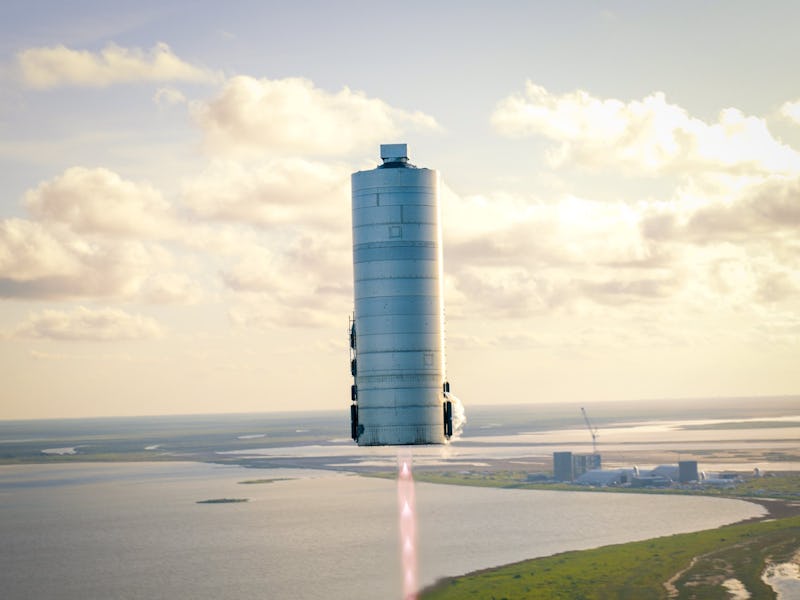SpaceX Starship: jaw-dropping images capture the shiny prototype in flight
The Starship, SpaceX's under-construction ship destined for the moon and Mars, has taken its first flight.

The Starship, SpaceX's under-construction rocket designed to send humans to Mars and beyond, has taken its first flight in prototype form.
On Friday, SpaceX CEO Elon Musk shared an image of the "SN5" prototype during this week's "hop test." This test sent the tank soaring into the air using a single off-center Raptor engine. The "SN5" vehicle flew nearly 500 feet into the air, around the same height as its "Starhopper" predecessor that took off in August 2019.
The successful launch is a key step in SpaceX's mission to finish the development of the Starship. First outlined under the name "BFR" in September 2017, the Starship is designed to take on missions currently reserved for the Falcon 9 like satellite launches. It's also a fully-reusable ship designed to send up to 150 tons or 100 people into space at a time. Its use of liquid oxygen and methane fuel means people can fly to Mars, harvest the planet's resources, and either return home or venture out further.
Perhaps little wonder, then, that Musk marked the August 4 flight by declaring on Twitter "Mars is looking real."
Musk's Starship image.
Steve Jurvetson, who sits on the SpaceX board of directors, responded to Musk's Friday image by sharing four further SpaceX drone shots:
Starship SN5.
The images highlight the asymmetrical placement of the Raptor engine, due to "SN5" originally expected to host three engines in a triangle configuration.
SN5 taking off.
The final Starship is expected to hold six engines. The ship will pair with the Super Heavy booster, expected to hold up to 37 engines.
Starship in flight.
The SpaceX drone images highlight how the "SN5" launch looks like a silo soaring into the air.
SN5 in flight.
Following the launch, SpaceX shared footage of the event on its YouTube account.
The Raptor engine lies at the heart of SpaceX's efforts to bring the Starship to light. The company first sent a Raptor-powered vehicle into the air back in August 2019. The "Starhopper" had the same nine-meter (30 feet) diameter as the final ship, but only measured 18 meters (60 feet) tall. The following month, Musk unveiled the "Starship Mk.1" with a 50-meter (164 feet) height that acted as the first full-size prototype. Unlike the "SN5," the "Mk.1" sported additional features like a nosecone designed to hold the cargo and pressurized cabin space.
Starship Mk.1.
The final ship, when paired with the Super Heavy booster, is expected to measure nearly 122 meters (400 feet). The Falcon 9, by comparison, measures just 70 meters (230 feet). The Starship and Super Heavy are expected to dramatically overshadow SpaceX's previous rocket.
Following the launch, SpaceX now plans to host a series of small hops. The next phase will then be to fly to higher altitudes using body flaps. Musk has previously suggested the company could host a 20-kilometer jump, but the exact height of future launches is unclear.
After that, SpaceX is expected to host a satellite launch with the Starship. The company has also outlined plans to send Japanese billionaire Yusaku Maezawa on a trip around the moon with six to eight artists as part of the "Dear Moon" mission. From there, the company is planning to continue with its plans to send humans to the moon and Mars.
The Inverse analysis – These clearer images give us the best view yet of the Starship launch earlier this week. Although it's an early prototype, it's a clear step toward SpaceX's most eye-catching goals to send humans to Mars and start a planet-hopping network.
It's unclear when SpaceX will be finished with Starship development, but the successful launch bodes well for the company's future plans.
THE STARSHIP’S JOURNEY, SUMMARIZED
- November 2018 – BFR, first announced in September 2017, gets renamed toStarship.
- December 2018 – Musk confirms the new ship has switched to stainless steel.
- January 2019 – Shortened “Starhopper” prototype unveiled and Musk explains the switch to steel.
- February 2019 – Raptor engine beats a long-standing rocket record.
- April 2019 – Starhopper completes a tethered “hop.”
- July 2019 – Starhopper launches 20 meters (67 feet).
- August 2019 – Starhopper launches 150 meters (500 feet).
- September 2019 – Starship Mk.1 full-size prototype unveiled.
- May 2020 – Starship SN4 full-size prototype completes a static test fire.
- August 2020 – Starship SN5 launches 150 meters (500 feet).